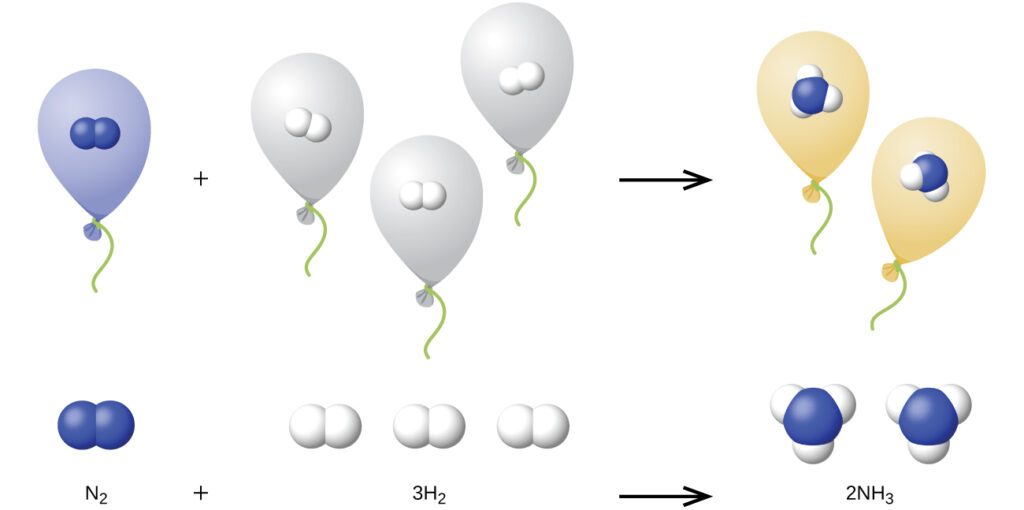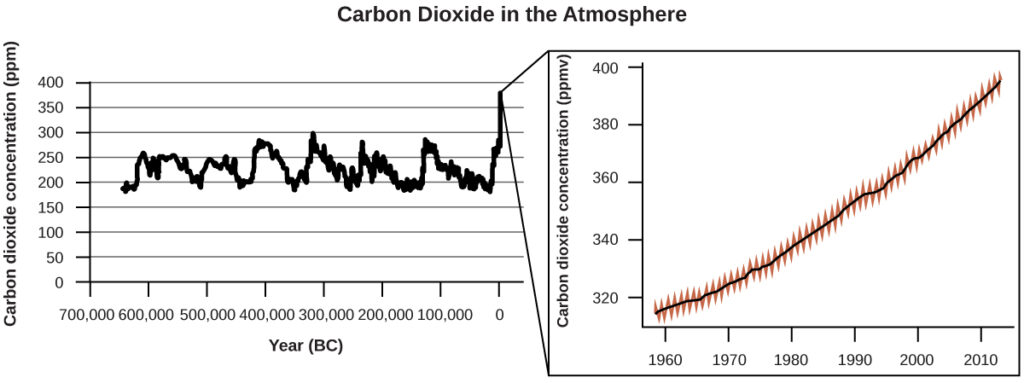Sometimes we can take advantage of a simplifying feature of the stoichiometry of gases that solids and solutions do not exhibit: All gases that show ideal behavior contain the same number of molecules in the same volume (at the same temperature and pressure). Thus, the ratios of volumes of gases involved in a chemical reaction are given by the coefficients in the equation for the reaction, provided that the gas volumes are measured at the same temperature and pressure.
We can extend Avogadro’s law (that the volume of a gas is directly proportional to the number of moles of the gas) to chemical reactions with gases: Gases combine, or react, in definite and simple proportions by volume, provided that all gas volumes are measured at the same temperature and pressure. For example, since nitrogen and hydrogen gases react to produce ammonia gas according to $N_2\;(g)+3H_2\;(g)⟶2NH_3\;(g)$, a given volume of nitrogen gas reacts with three times that volume of hydrogen gas to produce two times that volume of ammonia gas, if pressure and temperature remain constant.
The explanation for this is illustrated in [link]. According to Avogadro’s law, equal volumes of gaseous N2, H2, and NH3, at the same temperature and pressure, contain the same number of molecules. Because one molecule of N2 reacts with three molecules of H2 to produce two molecules of NH3, the volume of H2 required is three times the volume of N2, and the volume of NH3 produced is two times the volume of N2.

Reaction of Gases
Propane, C3H8(g), is used in gas grills to provide the heat for cooking. What volume of O2(g) measured at 25 °C and 760 torr is required to react with 2.7 L of propane measured under the same conditions of temperature and pressure? Assume that the propane undergoes complete combustion.
Solution
The ratio of the volumes of C3H8 and O2 will be equal to the ratio of their coefficients in the balanced equation for the reaction:
| $C_3H_8\;(g)+5O_2\;(g)$ | ⟶ | $3CO_2\;(g)+4H_2O\;(l)$ |
| 1 volume + 5 volumes | 3 volumes + 4 volumes |
From the equation, we see that one volume of C3H8 will react with five volumes of O2:
$$2.7\;\require{enclose}\enclose{horizontalstrike}{L\;C_3H_8}\times \frac{5\;L\;O_2}{1\;\enclose{horizontalstrike}{L\;C_3H_8}}=13.5\;L\;O_2$$
A volume of 13.5 L of O2 will be required to react with 2.7 L of C3H8.
Check Your Learning
An acetylene tank for an oxyacetylene welding torch provides 9340 L of acetylene gas, C2H2, at 0 °C and 1 atm. How many tanks of oxygen, each providing 7.00 ×103 L of O2 at 0 °C and 1 atm, will be required to burn the acetylene?
$$2C_2H_2+5O_2⟶4CO_2+2H_2O$$
Answer:
3.34 tanks (2.34 ×104 L)
Volumes of Reacting Gases
Ammonia is an important fertilizer and industrial chemical. Suppose that a volume of 683 billion cubic feet of gaseous ammonia, measured at 25 °C and 1 atm, was manufactured. What volume of H2(g), measured under the same conditions, was required to prepare this amount of ammonia by reaction with N2?
$$N_2\;(g)+3H_2\;(g)⟶2NH_3\;(g)$$
Solution
Because equal volumes of H2 and NH3 contain equal numbers of molecules and each three molecules of H2 that react produce two molecules of NH3, the ratio of the volumes of H2 and NH3 will be equal to 3:2. Two volumes of NH3, in this case in units of billion ft3, will be formed from three volumes of H2:
$$683\;billion\;ft^3\;NH_3\times \frac{3\;billion\;ft^3\;H_2}{2\;billion\;ft^3\;NH_3}=1.02×10^3\;billion\;ft^3\;H_2$$
The manufacture of 683 billion ft3 of NH3 required 1020 billion ft3 of H2. (At 25 °C and 1 atm, this is the volume of a cube with an edge length of approximately 1.9 miles.)
Check Your Learning
What volume of O2(g) measured at 25 °C and 760 torr is required to react with 17.0 L of ethylene, C2H4(g), measured under the same conditions of temperature and pressure? The products are CO2 and water vapor. Answer:
51.0 L
Volume of Gaseous Product
What volume of hydrogen at 27 °C and 723 torr may be prepared by the reaction of 8.88 g of gallium with an excess of hydrochloric acid?
$$2Ga\;(s)+6HCl\;(aq)⟶2GaCl_3\;(aq)+3H_2\;(g)$$
Solution
Convert the provided mass of the limiting reactant, Ga, to moles of hydrogen produced:
$$8.88\;\enclose{horizontalstrike}{g\;Ga}\times\frac{1\;\enclose{horizontalstrike}{mol\;Ga}}{69.723\;\enclose{horizontalstrike}{g\;Ga}}\times\frac{3\;mol\;H_2}{2\;\enclose{horizontalstrike}{mol\;Ga}}=0.191\;mol\;H_2$$
Convert the provided temperature and pressure values to appropriate units (K and atm, respectively), and then use the molar amount of hydrogen gas and the ideal gas equation to calculate the volume of gas:
$$V=(\frac{nRT}{P})=\frac{0.191\;\enclose{horizontalstrike}{mol}×0.08206\;L\;\enclose{horizontalstrike}{atm\;mol^{−1}K^{−1}}×300\;\enclose{horizontalstrike}{K}}{0.951\;\enclose{horizontalstrike}{atm}}=4.94\;L$$
Check Your Learning
Sulfur dioxide is an intermediate in the preparation of sulfuric acid. What volume of SO2 at 343 °C and 1.21 atm is produced by burning l.00 kg of sulfur in excess oxygen?
Answer:
1.30 × 103 L
Greenhouse Gases and Climate Change
The thin skin of our atmosphere keeps the earth from being an ice planet and makes it habitable. In fact, this is due to less than 0.5% of the air molecules. Of the energy from the sun that reaches the earth, almost $\frac{1}{3}$ is reflected back into space, with the rest absorbed by the atmosphere and the surface of the earth. Some of the energy that the earth absorbs is re-emitted as infrared (IR) radiation, a portion of which passes back out through the atmosphere into space. Most if this IR radiation, however, is absorbed by certain atmospheric gases, effectively trapping heat within the atmosphere in a phenomenon known as the greenhouse effect. This effect maintains global temperatures within the range needed to sustain life on earth. Without our atmosphere, the earth’s average temperature would be lower by more than 30 °C (nearly 60 °F). The major greenhouse gases (GHGs) are water vapor, carbon dioxide, methane, and ozone. Since the Industrial Revolution, human activity has been increasing the concentrations of GHGs, which have changed the energy balance and are significantly altering the earth’s climate ([link]).

There is strong evidence from multiple sources that higher atmospheric levels of CO2 are caused by human activity, with fossil fuel burning accounting for about $\frac{3}{4}$ of the recent increase in CO2. Reliable data from ice cores reveals that CO2 concentration in the atmosphere is at the highest level in the past 800,000 years; other evidence indicates that it may be at its highest level in 20 million years. In recent years, the CO2 concentration has increased preindustrial levels of ~280 ppm to more than 400 ppm today ([link]).

Click here to see a 2-minute video explaining greenhouse gases and global warming.
Portrait of a Chemist
Susan Solomon
Atmospheric and climate scientist Susan Solomon ([link]) is the author of one of The New York Times books of the year (The Coldest March, 2001), one of Time magazine’s 100 most influential people in the world (2008), and a working group leader of the Intergovernmental Panel on Climate Change (IPCC), which was the recipient of the 2007 Nobel Peace Prize. She helped determine and explain the cause of the formation of the ozone hole over Antarctica, and has authored many important papers on climate change. She has been awarded the top scientific honors in the US and France (the National Medal of Science and the Grande Medaille, respectively), and is a member of the National Academy of Sciences, the Royal Society, the French Academy of Sciences, and the European Academy of Sciences. Formerly a professor at the University of Colorado, she is now at MIT, and continues to work at NOAA.
For more information, watch this video about Susan Solomon.
